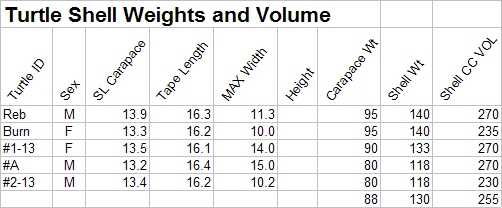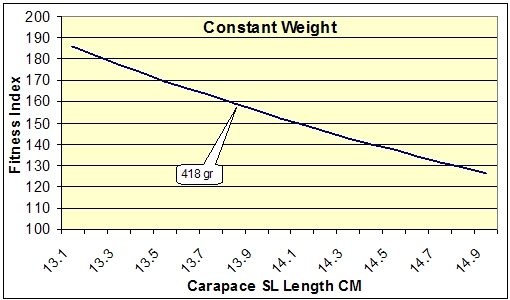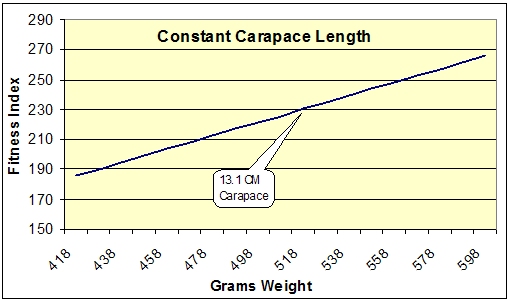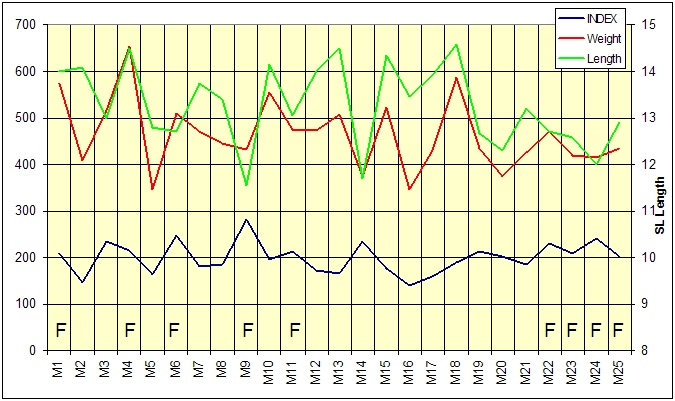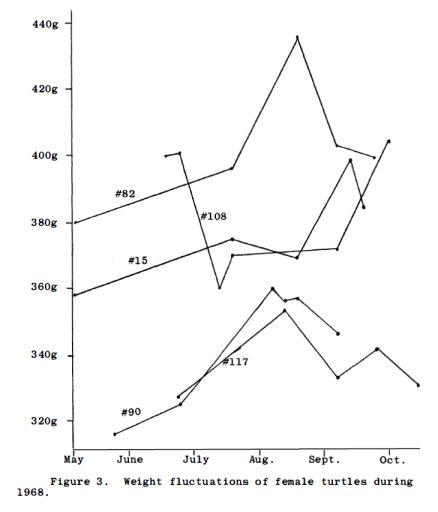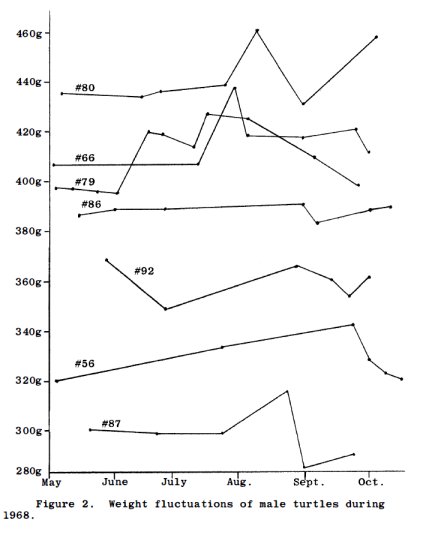In March 2013, I was introduced to the concept of "Fitness Index" at a Box turtle conservation workshop. It seemed that it could be a useful measurement in evaluating a local population, or for comparing populations, or most likely for tracking individuals in a population.
Is This a Legitimate Metric? What are It's Applications?
UNDER CONSTRUCTION 2/16/14
A small number of Box turtle shells found within the study area were measured for internal volume using small plastic beads. A larger sample including smaller and larger turtles is needed to construct a "look-up" table to be used with live turtles.
Box turtle "Reb" is complete with plastron and keratin scutes. The carapace and plastron weights were compared to suggest the total weights of shells of live turtles. Approximately 32% to 34% of a turtle's shell is plastron weight. Total shell weight can be calculated when only the carapace is found.
What is "fitness"? The term is often paired with the term "health", so what is fitness when used alone? A Box turtle injury (i.e. by predator), is temporary, chronic, or terminal. Box turtle disease is a disease, dehydration is dehydration. None of these examples seem to have anything to do with what we normally think of as "fitness", or "fitness level" separate from disease, injury, and other medical issues.
Box turtle fitness index is based on 2 measurements: turtle weight (grams) and carapace straight-line length (cm).
FITNESS INDEX = (Weight / (Carapace SL Length ^3)) * 1000
Example of Fitness Index of a large adult turtle with a 13.1cm carapace. Ten grams (the volume of a typical urination or a handful of berries) makes a large difference in index value.
Example of Fitness Index of large adult turtles of the same weight. A change of ten milimeters length makes a big difference.
The column to the left is the 2013 season weights of 18 turtles in this study site. Each turtle was weighed 1 or 2 days after emergence, every couple or few weeks during the summer, and within a week or two before hibernation. Weights are grams, and weight highlighted in red is the maximum recorded weight for that turtle for the season.
These turtles always emerge from hibernation very muddy and wet and well hydrated, and enter hibernation prepared to go without replenishing food or energy sources for 5 to 7 months. Or at least that's what I thought. Mammals prepare for true hibernation by putting large on fat reserves.
But the time of maximum weight of each of these turtles was not consistent . Some turtles were heaviest when freshly emerged, some heaviest during mid season, and some near season's end and hibernation.
Large percent swings over the summer are more significant than immediately apparent, since the heavy carapace+plastron don't change (significantly) during the season: only the soft tissue weight changes.
This chart shows Fitness Index's for 25 turtles in this study area, based on their maximum recorded weights and lengths.
The chart would suggest a gender bias, based at least partly on shorter, compact carapace.
So How Can This Be Fixed?
Firstly, I'm not certain there is anything to fix, because I don't know what the variables represent.
It seems that the weight (mass) variable is weighted incorrectly, as it includes shell weight which does not change (much) during a season, or even season to season. The carapace SL length cubed is a box into which the turtle will fit with LOTS of room to spare.
The variable weight of a turtle is the soft tissue inside the shell, so a representative weight for fitness calculation would be total weight minus shell weight. This Net Weight value calculated for adults is 62% to 76% of total weight.
The volume in which this soft tissue grows is the volume inside the shell in cubic cm.
Chart showing Fitness Index for all turtles in this healthy local population
Calculated net weights and volumes for a selection of this site's turtles with sizes i the range of thurtle shells measured for volume.
Terrapene carolina carolina
A Relict Population Doomed To Extinction?
